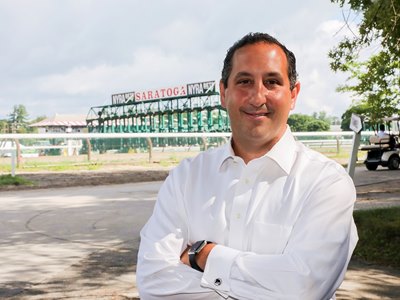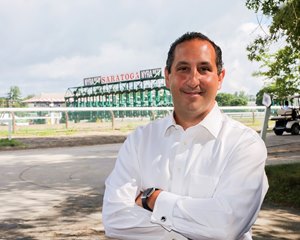Cannizzo Reflects on Time at NYTB


With nearly 13 years on the job as executive director of New York Thoroughbred Breeders, Jeffrey Cannizzo is moving to the New York Racing Association starting Jan. 4 as its senior director of government affairs. Breeding and racing Thoroughbreds in New York have witnessed explosive growth over the last decade during Cannizzo's tenure. BloodHorse editorial director Evan Hammonds asked Cannizzo a few questions as he began to transition from his position that has now been filled by Najja Thompson. (This piece previously appeared in New York Breeder magazine)
BloodHorse: You took the executive director's job after working with companies such as Lockheed Martin, Dell, and Microsoft. What was the hook to the Thoroughbred industry?
Jeffrey Cannizzo: Fifteen or so years ago you would have never known (on paper) that my roots were embedded into the Thoroughbred industry. I was a typical young corporate employee trying to make a name for myself working in Manhattan for a few Fortune 100 companies. Little did any of those managers back then know that every moment outside of the office was spent wrapped around racing. My great grandfather was invested in the industry, and that's how the lineage began. It's been several generations of introduction and involvement with the sport. The running joke was that my first book report was on "how to read the Form."
I spent many weekends on the backstretch of Finger Lakes, and I used to bring every childhood friend to the track. I conducted owner seminars to the youth. So, I grew up directly involved … just not employed. I never imagined I would be; then, in 2007 or so, I met Julie Levine, a recruiter for the New York Racing Association, and she put the idea in my head, "why not work in racing?"
I became obsessed with the idea and luckily for me New York Thoroughbred Breeders had the executive director position open at the time. I applied and the board of directors asked, "Why do you want to be in this industry?" because my résumé had nothing to do with horses. I asked for 15 minutes to explain. And here I am today.
BH: What were your expectations when you took the job?
JC: Honestly, I thought, well, if I am a colossal dud, I can just revert back to the city and work in technology consulting. I took a 60% salary reduction to come to NYTB. I virtually rolled the dice and packed my bags. I was coming from a corporate environment to a tiny small business office of two or three in downtown Saratoga Springs. I believed I could make a difference one way or another. I am completely stubborn and do not like losing, and in my mind it was all about winning and proving something. There were many people who thought I was crazy making the change.
My expectation was to establish relationships that could create change, and I wanted to become an entrusted partner to change the organization for the better. The way you do that is systematic, and you need support from others, so I tried to establish true relationships based on the simple approach of making our industry better. Looking back, I think the results have been positive.

BH: Resorts World Casino at Aqueduct Racetrack opened in 2011. Walk us through some of the issues at the time to get it up and running.
JC: After a decade of toil, trouble, and turmoil, video lottery terminals (VLTs) finally began operating at Aqueduct Oct. 28, 2011. Because of political roadblocks and assorted shenanigans, much of it fueled by ingrained, deep-seated animosity toward NYRA, Aqueduct was the last racing entity to receive VLT gaming after their legislative approval following Sept. 11, 2001. The process from 2008 to 2011 was a roller coaster. It was dead, alive, suspended, litigated, blacklisted; you can pick any word and interject it into the process. There were many grassroot political campaigns that we led back then with much hard-nosed lobbying. The irony was that I had zero experience in the government affairs arena. My claim to fame was that I was responsible for bringing the only truck and trailer with broodmares on it, along with hundreds of farm employees, and letting them have a rally on the lawn of the Capitol in Albany. At the end of the day Genting paid the state of New York a $380 million upfront franchise fee in September 2010 and that's how the ball got rolling.
BH: Casino revenue has been a big boost to the state's breeding program, purses, sale ring, and in the breeding shed. Where would the industry be without it?
JC: New York would be similar to every other state without alternative gaming. Reduced days, reduced purses, reduced owners, reduced meets, and a shrinking foal crop. Don't get me wrong, those are the same issues we all face right now across the country even with gaming (that's a different story). The difference is that New York would have never seen the increases we have over the last decade without the added revenue source. It stabilized NYRA's capital and operating budgets by more than $40 million a year to allow true track development. The revenue boosted purses by $60 million annually. It adds $15 million to the State Breeding Fund each year. This money has allowed more owners to stay in the sport longer in New York and to reinvest. The enhanced purse structure has allowed NYRA to put millions more in the state-bred program. Only because of this has the commercial market appeared for New York-breds. The value of a New York-bred is 100% directly correlated to this. It's a value proposition. If you take that money out of the system we'd see exactly what the rest of the industry is seeing: significant reduction. You'd have 40% or more breeders and owners out of the industry in New York. There would be an even more dramatic horse shortage, if you could imagine that, as our state-bred pool accounts for 50% of the starters.
The cost of doing business here would eliminate the true New York horsemen and breeders way beyond our current issues as we know them today. Without participants the sport falls apart.
BH: What have been the industry's biggest challenges in the state?
JC: Our industry has so many fundamental challenges, and we are so good at talking about them. Acting and delivering is what truly matters. We need to deliver a more sustainable business model for everyone, for the tracks, the owners, breeders, and a better product for the player. How? Increase revenue to the tracks, reduce owners' expenses while driving more purse money, enable longer ownership which will create more demand from breeders and all resulting in an increase in field size for the bettors.
The tracks need to be paid properly for their content production and delivery. The ADW (advance-deposit wagering) model is critically flawed for producers. We enable the middleman to take advantage of the show we produce and pay to maintain. Handle has shifted from brick and mortar to the ADW platform and this year has expedited the shift dramatically.
On the horsemen's side, the cost of doing business in New York is eliminating people by the day. We need to reduce those costs by increasing revenues like the above-mentioned model and put the money back into the system to reduce our investor (horsemen and breeders) expenses. We need to hit the red reset button. As we know from experience change is difficult and normally only happens when a crisis is presented.
BH: Wagering online on sports is the next frontier across the country. Is that a good thing for racing in New York, or not?
JC: I view sports betting as an opportunity. The true litmus test has been in New Jersey, and it proved to enhance the pari-mutuel market thus far. It's a low-margin industry. No one is raking in cash from the sports betting market, which is one of the biggest misconceptions. In the gaming space it is viewed as a loss leader. The keys are the ability to deliver a quality product side by side a sporting event and be in front of that new audience on TV or a digital platform and being able to use a NYRA Bets account to place a sports bet and perhaps vice versa—giving a sports-betting platform racing content to distribute.
If we can grow pari-mutuel wagering from having sports alongside of it, that is the true opportunity for us to increase revenue. Who knows; this could lead into fixed odds wagering as a result which could have value to us.
BH: Have a favorite race or favorite horse from your tenure?
JC: I have a few and have been lucky to be involved with the New York-bred renaissance since 2008. If this was a normal year Tiz the Law would have been a great Belmont Stakes (G1) and Travers Stakes (G1) to witness in person. However, watching Diversify win the Whitney Stakes (G1) for Rick Violette was emotional. Seeing Mind Your Biscuits win in Dubai was exhilarating. But standing in the winner's circle with my friend Chester Broman at the Breeders' Cup with Bar of Gold holds a special place for me.

BH: What are the biggest challenges for the next executive director?
JC: Navigation. We are all riding on this ship, and we need people who can steer it in the correct direction. We have a lot of shipmates and deckhands who have all the ideas. We need leaders who can actually create change. Keeping our New York industry funded and enabling revenue growth is the biggest challenge. Even though New York-breds won't be my focus, I will always support the program no matter what I am doing.
